1. Overview
Welding the steel structure of a tower furnace is a complex and challenging task. The ability to overcome these technical challenges demonstrates a company's expertise and market competitiveness. Our company has accumulated extensive experience in the production and welding of auxiliary steel frames for power plants, continuously refining our processes to enhance product quality. Figure 1 shows the overall structure of the tower furnace auxiliary steel frame.

Figure 1
2. Tower Furnace Structure
The 1000MW unit consists of two main parts: the main steel frame of the tower furnace and the top steel frame. The main steel frame serves as the primary load-bearing structure of the boiler. It is a cylindrical framework standing at 113.2 meters tall with five levels, composed of four columns, 20 main beams, and 40 diagonal braces.
(1) Each column is divided into eight sections (first layer second stage, second layer second section, third layer first section, fourth layer second section, fifth layer first section), totaling 32 sections. Each section is approximately 16 meters long and weighs around 80 tons. The lower section measures 2500mm × 2500mm × 45mm, while the upper section has a minimum dimension of 2000mm × 1700mm × 45mm. There are multiple horizontal partitions in the column, eight T-shaped stiffeners in the longitudinal direction, and two ladders. The upper and lower columns are bolted together through flanges, with four partial penetration fillet welds and a 10 mm internal fillet weld.
(2) Each layer includes four main beams with cross-sectional dimensions of 2000mm × 900mm × 30mm × 40mm. The diagonal bracing steel plates are 28 meters long and weigh about 75 tons.
(3) Each of the eight layers of the diagonal bracing has a cross-sectional dimension of 1200mm × 900mm × 30mm × 35mm/40mm, a length of 22 meters, and a weight of about 30 tons. The single-layer structure is shown in Figure 2.
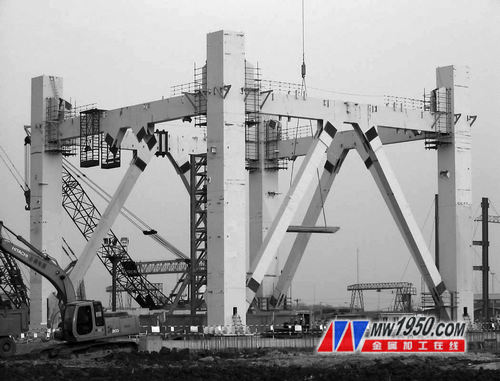
Figure 2
The column is box-shaped, with a section size of 2500mm × 2500mm, a length of about 16 meters, and a web and flange thickness of 45mm. Four main fillet welds are semi-penetrated in the groove, with a 10mm fillet weld inside the box. The column has several holes connecting to the main beam on the horizontal plane, and an internal "well"-shaped reinforcing structure. There are five layers of partitions at different elevations (excluding the platform), and two T-shaped reinforcing plates are installed in the longitudinal direction of the flange and web. The flange plate thickness at the top and bottom ends of the column is 35mm (end-milled surface), and the T-shaped reinforcing plate and partition plates H, E, M, B use penetration fillet welds.
3. Fabrication and Welding Challenges of Steel Columns
The auxiliary steel frame is large in size, thick in steel plates, and rigid, making it difficult to control welding deformation. The dimensional accuracy of the column members is high (see Table 1).
Table 1

(1) The large cross-section of the box-type column and the complex structure of thick plates make welding particularly critical. With many weld beads, even minor mistakes during welding can lead to defects, resulting in unqualified flaw detection. The column contains five layers of reinforcing partitions and the main body, with penetration, semi-penetration, and fillet welds. The welding workload is high, and the conditions are poor, making the technique challenging. Submerged arc welding and CO2 gas shielded welding (flux-cored and solid wires) are mainly used due to their high efficiency and good performance. All penetration and semi-penetration welds undergo 100% UT inspection.
(2) Box-type steel plates are made from national standard Q345B and American standard A572Gr50, with a thickness of 45mm. Although the same steel number is used, the carbon content is higher compared to the national standard, requiring preheating before welding and post-weld heat treatment. If the welder is careless, cracks may occur. The assembly precision of the box web, flange, transverse partition, and longitudinal stiffener is high, leading to significant welding deformation. The key challenge is preventing distortion of the box column. Factors like assembly size, clearance, welding parameters, sequence, and operator awareness affect welding shrinkage and stress, causing excessive deformation. Due to the high rigidity of the box column, correction after deformation is difficult, posing a major challenge in production and deformation control. To ensure welding quality and dimensional accuracy, we guarantee the position, angle, root gap, and welding sequence of the grooves, along with qualified welding procedures and tooling measures. After beam production, inspection and measurement are carried out to ensure components meet factory standards. The column body is shown in Figure 3. Various joint forms of the column are shown in Figure 4.
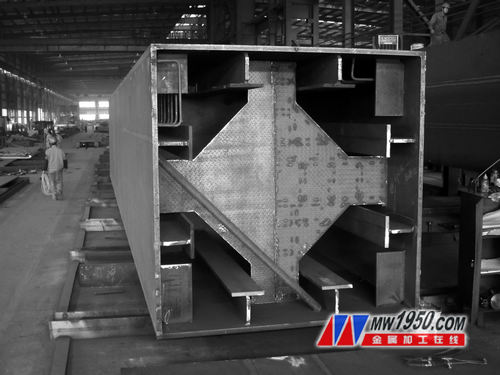
Figure 3
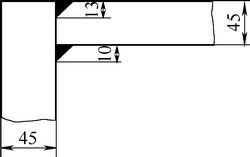
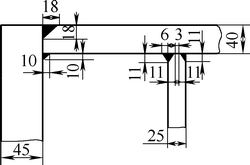

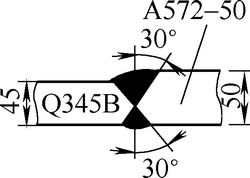
Figure 4: Column various joint forms
4. Steel Frame and Welding Tests
(1) The steel used is national standard Q345B and American standard A572Gr50. Their chemical composition and mechanical properties are shown in Table 2.
Table 2: Mechanical properties and chemical composition of different plate thicknesses

Chart 2 indicates that A572Gr50 and Q345B have similar mechanical properties and chemical compositions. Before the project began, welding materials compatible with Q345B were tested using submerged arc and CO2 gas shielded welding. Preheating of test plates, controlled interpass temperatures, and post-weld heat treatment at 630°C were conducted. After 100% UT inspection, the mechanical tests fully met the AWS-D1.1 standard. The welding process evaluation data are shown in Table 3.
Table 3: Welding process evaluation physical data

(2) Submerged arc welding wire uses iron anchor H10Mn2, flux uses Yulin SJ101/F48A2, and welding equipment uses Tangshan Matsushita Group ZD5-1250, as shown in Figure 5. Welding parameters are listed in Table 4.
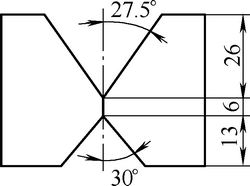
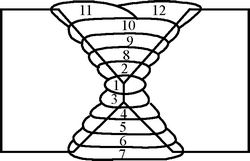
(a) (b)
Figure 5
Table 4: Submerged arc welding parameters

(3) For CO2 gas welding, the wire is Wuhan iron anchor cored wire YCJ501-1 and solid wire WH50-6, with welding machine Tangshan Panasonic KRII500. Figure 6 shows the groove form and welding sequence. Welding parameters are listed in Table 5.
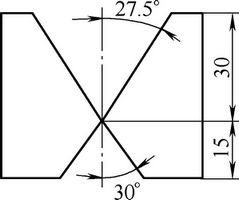
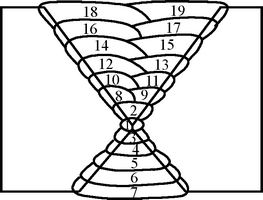
(a) Groove form (b) FCAW
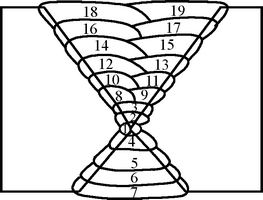
(c) GMAW
Figure 6
Table 5: CO2 gas shielded welding parameters
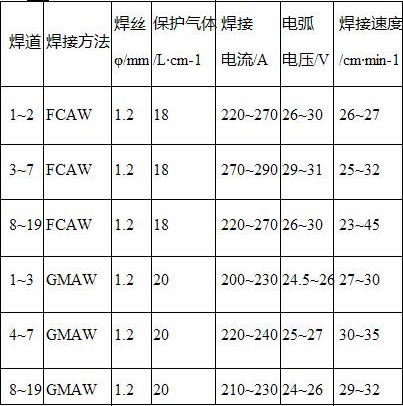
5. Fabrication and Welding of Box Columns
The most important technical requirement for welding box-type column webs and flanges is proper preparation before welding, such as rod baking, gas heating, bead cleaning, and preheating. Interlayer temperature control and slag removal are also essential. Oxide crystals on the surface of CO2 gas shielded welds can affect internal quality. Since thick plates are hard to repair if defective, strict quality control is necessary.
(1) Assemble the steel column’s planar projection on the ground, mark the outline, center line, and end position line, and create a platform tire frame. When setting up the platform, consider the spreader width for easy operation. Ensure the tire frame elevation is on the same horizontal line. Use CNC-cut bottom plates to hang the tire frame, draw the center line, balance lines, and strengthen positioning. Align the bottom plate center with the ground center. Start with small-stack assembly and welding. After flaw detection, level the base, then attach and accurately position the bottom plate. After welding, draw the positioning lines for the partition plate, end plate, and T-shaped rib as installation references. The T-shaped rib is based on the theoretical length plus a welding shrinkage margin. Qualified T-shaped ribs are hung and positioned according to the drawn lines. Spot welding starts from the middle, with vertical supports added to reduce deformation. The T-shaped rib end is grooved and welded through the diaphragm. ≥25mm plates must be preheated regardless of joint type, and welding can proceed once requirements are met. The bottom plate is shown in Figure 7.
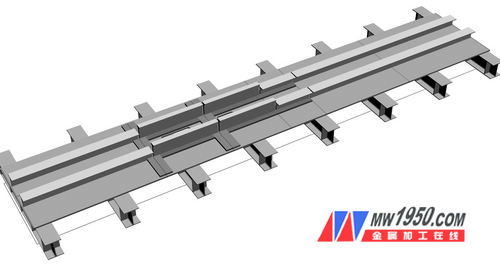
Figure 7
(2) Cut the assembled partition plate using CNC, smooth the free edge to ensure tight contact with the web and flange. After NC cutting, assemble the end plates into a frame, level after welding, and measure the cross-section and diagonal dimensions to ensure 90° corners. Draw the cross center line and threaded hole positions on the frame. The column connection flange requires stacking drilling. The bottom end plate has countersunk bolt holes. When assembling the end plate, align its center with the bottom plate center, match the balance line with the installation line, and control the verticality between the end line and the bottom plate. Add support on both sides of the T-shaped rib wing to prevent deformation during welding. The bottom plate is shown in Figure 8.
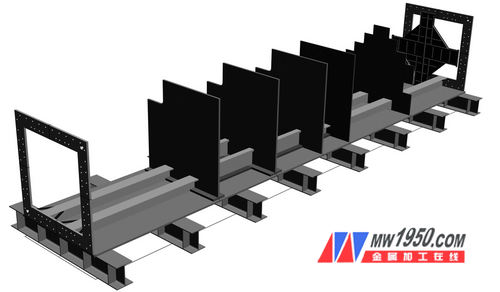
Figure 8
(3) Assemble the web panel and T-shaped rib according to the above method, install lifting codes, and align the web end center line with the end plate center line. Ensure alignment with the bottom plate. Secure the partition and maintain overall verticality. Install left and right webs in order to control diagonal misalignment ≤3mm for positioning welding. For every 400mm spacing, the weld length is 30~40mm. After assembly, pre-accept the groove type and proceed with welding. To control component size and welding deformation, first weld the partition and web symmetrically. After completing the web and floor fillet weld, ensure symmetry on both sides. From the center to the edges, at least four welders are involved. After welding the longitudinal T-shaped plate and partition, weld the bottom plate and partition fillet weld. The bottom plate and web are shown in Figure 9.


(a) Bottom plate (b) Web
Figure 9
(4) When assembling the cover plate, align the end center line with the end plate cross center line for positioning. After re-measuring the box column size, check the symmetry of the upper and lower center lines and verticality. The four main welds are 100mm wide. Preheat before welding (electric or flame heating). Electric heating is recorded by an automatic temperature controller, while flame heating is measured at the center of the groove, 75mm on each side, set to 60–70°C. Weld according to requirements. Since the four main welds haven't been welded yet, turning could cause deformation. Therefore, the cover plate and web are welded horizontally using CO2 flux-cored wire protection welding, which has small heat input and deformation. Four welders work from the center to the edges to complete the four main welds. After multiple layers of welding to 2–3mm, turn 90° and perform submerged arc welding; then turn 180°, and weld one side with submerged arc welding simultaneously, minimizing member deformation.
(5) After face milling, flaw detection, correction, and measurement, draw the center line on all four sides, mark the end milling allowance line at both ends, and control the matching line. The distance of the matching line is 200mm, and it is perpendicular to the centerline and tested. Then perform the upper end milling. Before milling, adjust the centerline level to within ±1mm, measure the verticality of the power head, and control the distance between the power head surface and the residual line to ensure the end face perpendicularity and component length are within tolerance.
(6) Drill holes on the column to determine the beam end plate installation position. Fix the end plate and column, and draw the hole group position line. During scribing, the horizontal direction is based on the column bottom plate center line, and the longitudinal direction is based on the column center line. Drill holes with the end plate. Before positioning the beam end plate and column, flatten and tighten the upper and lower parts of the end plate with a clamp, as shown in Figure 10.

Figure 10
6. Conclusion
The box-type column is inspected for VT appearance, welding size, and 100% UT inspection according to GB50205-2001 standards. The structural size is checked one by one according to Table 1. The production quality fully complies with the predetermined technical requirements. Due to strict control of the assembly and welding process, the deformation of the box-type column is effectively controlled. Additionally, the use of beam plate and column hole stack drilling ensures a 100% hole rate, significantly reducing hole deviation. This advancement enables the company to take a major step forward in the production of auxiliary steel frames for power plants, ensuring successful field installation on the first attempt.
Bearing lubrication grease ,Industrial lubricant,Synthetic bearing grease ,High-load resistance, Adhesive lubricating oil
Yuyao Shuguang stainless steel bearing Co., LTD , https://www.shuguangbearing.com